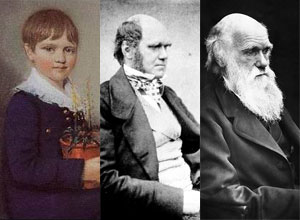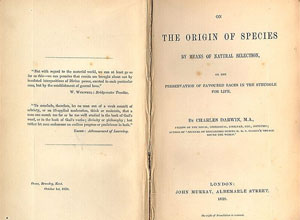This page has been archived and is no longer updated

Like so many great scientists, Charles Darwin was first drawn to science as a young boy by his intense interest in the diverse animals and plants that filled his surroundings. Later, despite his father's urgings to pursue a career in medicine, young Darwin found himself drawn to careful, empirical observation of nature, particularly through his cherished hobby of collecting beetles. His empirical instincts were further developed at the University of Cambridge through deep study under contemporary naturalists, such as John Stevens Henslow, founder of the Cambridge University Botanic Garden (1831), and through reading progressive philosophers, such as William Paley, author of Natural Theology (1802). By the time he was serendipitously invited to accompany Captain Robert FitzRoy on a voyage of the HMS Beagle, Darwin had become an astute and insatiable scientist, primed for significant discoveries.
Who could have imagined how significant his discoveries would be? Even Darwin himself may not have immediately realized their importance. For fifteen years after his voyage aboard the Beagle, he primarily devoted himself to writings on geology, working on his new ideas of natural selection and evolution in the background. When On the Origin of Species was finally published in 1859, the first print run of 1,250 books went mostly unsold. In 1860, however, the work began to attract wide critical response. A book review of Origin by Asa Gray in the Atlantic Monthly that year (link below) combined admiration of Darwin's "eloquent" ideas with concern that the ideas "presaged no good to old beliefs." In other quarters, both religious and scientific, Darwin was bitterly attacked for his supposed creed that men came from monkeys. Even Henslow, his former tutor, publicly disagreed with Darwin's theories. But gradually the profundity of Darwin's insight swept away the criticism, achieving broad consensus among both the scientific community and people from all walks of life. When John Scopes, a U.S. schoolteacher in the state of Tennessee, was charged and convicted of violating a state law prohibiting the teaching of Darwin's theory in 1925, it was the anti-evolution parties, not the pro-evolution ones, that were the object of widespread public ridicule. Darwin had changed the way the human race perceived its place in the universe.
Over the 127 years since Darwin's death, his theory has grown even more influential, spawning numerous groundbreaking theories in the life sciences, such as the theory of "punctuated equilibrium" developed by Steven Jay Gould and Niles Eldredge (1972). Just as powerful (and unfortunate) a testament to Darwin's influence is the number of spurious applications of his theory over the years to political, social, and economic analyses, most prominently the theory of "social Darwinism" which, in the late nineteenth century, was used to justify racism in the name of pseudo-science. It is, therefore, small wonder that Darwin is frequently listed among the small handful of most influential people in human history.
Today, Darwin's theories are as passionate a matter of public debate as they were at any time in the past. Several prominent groups (many of them fundamentalist Christian in origin) argue in favor of a theory of divinely powered "intelligent design" as an alternative to the purely scientific theory of evolution, and some even argue against the basic idea that the human race has evolved at all over its history.
So, as the 200th anniversary of Darwin's birth draws to a close, we celebrate a life that has never truly ended, but continues to be a powerful cultural and scientific influence. In this Spotlight, we survey the three acts of Darwin's extended life: his formative years, his major scientific discoveries, and the dynamic and compounding impact of his ideas on human thought after his death. The resources gathered for you here, ranging from a book review published in 1860 to recent reflections by scientists in 2009, will help you trace the profound ways in which science can uniquely transform human life.
Image: Ellen Sharples, Charles Darwin at age Seven, 1816; Mauli and Fox, Charles Darwin, circa 1850-1860; J. Cameron, Charles Darwin, 1869.
Listen to a discussion about Darwin's garden and his beginnings as a botanist.
See what Darwin's experience aboard the HMS Beagle in the Galapagos was like.
Read how the London area was influential in shaping the naturalist.
In 1860, Asa Gray published a review of Darwin's book that addressed the parallel pursuit of supernatural and empirical explanations of the natural world.
John Whitfield parses each chapter of Darwin's greatest work from the perspective of a twenty-first century evolutionary biologist and blogger.
Trace Darwin's journey to see how the islands sparked his thoughts on evolution. This interactive map enables you to observe the islands as they are today.
Darwin and Alfred Russel Wallace devised similar ideas concurrently. Read how their colleagues handled this.
Scientific American's Darwin Day Special looks at an intelligent design trial, science in politics, and more.
Learn how Darwin's ideas have shaped modern thought and were inspired by centuries of philosophy and science.
In 2009, The Beagle Project rebuilt Darwin's ship and set sail to inspire global awareness of current environmental issues.
Read this resource from Nature to follow the trail of evidence supporting evolution by natural selection.
Darwin's legacy is alive in this state-of-the-art research facility, which also features a brilliant specimen collection.
Browse Darwin's letters with this online resource assembled by the University of Cambridge. Check back often, as more letters become available all the time.
This website contains over 87,000 pages of searchable text and 207,000 electronic images from Darwin's publications, reproduced to the highest scholarly standards.
Curious about Darwin's lesser-known works? This review provided by the Public Library of Science assesses his other publications and his unprinted notebooks.
